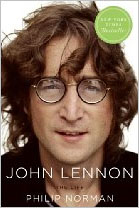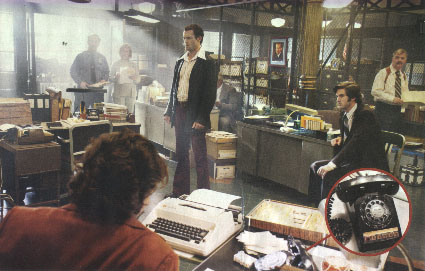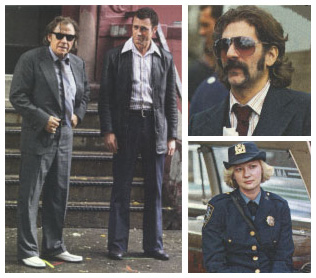![]()
| Meet the Beatle |
|
![]()
The real John Lennon steps forward in a brilliant bio
by Jeff Giles in Entertainment Weekly
John Lennon: The Life
Phillip Norman
Biography

![]() he Beatles have been the subject of so many books that the memories of everyone who ever knew, loved, or sponged off of them have been overharvested to the point of extinction. So why bother inviting Phillip Norman's new 851-page biography of John Lennon into your life? Even if the book is good, you'll just get swept up in how funny, brilliant, troubled, insecure, caustic, and loving Lennon was -- and then, just as you watch him turn 40 and find peace and rediscover his guitar, he'll get murdered after rushing home from the studio to tuck his boy into bed.
he Beatles have been the subject of so many books that the memories of everyone who ever knew, loved, or sponged off of them have been overharvested to the point of extinction. So why bother inviting Phillip Norman's new 851-page biography of John Lennon into your life? Even if the book is good, you'll just get swept up in how funny, brilliant, troubled, insecure, caustic, and loving Lennon was -- and then, just as you watch him turn 40 and find peace and rediscover his guitar, he'll get murdered after rushing home from the studio to tuck his boy into bed.
 The bad news is that John Lennon: The Life is so rich and enveloping that it demands to be read. Lennon's widow, Yoko Ono, gave Norman a series of frank interviews but later withdrew her support because she felt the book was "mean to John." Which simply isn't true. John Lennon may not beautify the singer, but it's a clear-eyed and compassionate study of a man who was idealistic enough to write "Imagine" but cynical enough to grouse to a friend, "It's only a bloody song."
The bad news is that John Lennon: The Life is so rich and enveloping that it demands to be read. Lennon's widow, Yoko Ono, gave Norman a series of frank interviews but later withdrew her support because she felt the book was "mean to John." Which simply isn't true. John Lennon may not beautify the singer, but it's a clear-eyed and compassionate study of a man who was idealistic enough to write "Imagine" but cynical enough to grouse to a friend, "It's only a bloody song."
Norman no doubt embarked on his book to balance the hagiographies of Lennon, as well as to exorcise the ghost of the late toxic avenger Albert Goldman, who published his fat, hateful biography, The Lives of John Lennon, 20 years ago. (Goldman had already roasted Elvis Presley over a spit, and portrayed Lennon as a nasty, bisexual, agoraphobic, anorexic junkie.) Norman, author of the Beatles history Shout!, conjures the singer's childhood, early years as a Beatle, and marriages in almost novelistic detail. He gently corrects myths that even the singer believed -- that his parents never loved or wanted him, for instance -- without trivializing the pain Lennon felt, or the shock waves it sent through his life. Norman coaxes fresh insights out of both Ono and producer George Martin. And, thanks to a rare interview with Sean Ono Lennon, he turns the postscript into a touching sort of hymn to a lost dad -- offered up, with pain we can only guess at, by the little boy who never did get tucked in. A- ![]()
| That Other '70s Show |
|
![]()
How 'Life on Mars' channels the Me Decade. Now that's groovy!
by Ileane Rudolph in TV Guide

![]() ow do you turn today's bright and shiny glass-towered Big Apple into the dangerous and run-down New York City of 1973? That's the challenge for the team behind Life on Mars, ABC's series centering on Sam Tyler (Jason O'Mara), a modern-day NYPD detective who's been mysteriously transported back to the disco era after being hit by a car in 2008. Exec producer André Nemec says he looked to movies of the period, like Serpico and The French Connection, for the feel of a city that was gritty, broke and violent. "But we didn't want it to look as bleak and washed-out as those films," he says. "We're a 2008 television series, so we want to keep the show alive and vibrant, while being authentic. Our goal is to create a look that's not trying to mock the '70s, but one that just lives there." Here's a behind-the-scenes tour of how the Life on Mars creative team has brought the decade back to life.
ow do you turn today's bright and shiny glass-towered Big Apple into the dangerous and run-down New York City of 1973? That's the challenge for the team behind Life on Mars, ABC's series centering on Sam Tyler (Jason O'Mara), a modern-day NYPD detective who's been mysteriously transported back to the disco era after being hit by a car in 2008. Exec producer André Nemec says he looked to movies of the period, like Serpico and The French Connection, for the feel of a city that was gritty, broke and violent. "But we didn't want it to look as bleak and washed-out as those films," he says. "We're a 2008 television series, so we want to keep the show alive and vibrant, while being authentic. Our goal is to create a look that's not trying to mock the '70s, but one that just lives there." Here's a behind-the-scenes tour of how the Life on Mars creative team has brought the decade back to life.
The Mod Squad Room "We built a massive precinct with a huge squad room, holding cells, interrogation rooms and various corridors and stairways that took two months to do," says production designer Stephen Hendrickson. "I did a smoky tobacco color scheme in the squad room that gives a sepia tint to everything, reflecting years of guys smoking cigarettes and cigars in the house. We have to be very careful that everything is accurate, so even the paperwork on the desk is old or re-created to look that way." Since New York City at the time was begging for funds, the propmaster made sure to fill the set with stuff that was out of date even then, like "lots of manual typewriters." Everything was deliberately mismatched -- except for the black rotary phones.
Far-out Fashions "We want everyone to look real, not cartoonish," says costume designer Woody Lane, who scours vintage stores every week. "Sam's signature look is his leather jacket. Then we add cords, gabardines or a great velour pant." O'Mara says he's down with the styles, though not with the polyester pants --  "The chafe in sensitive areas!" -- or the chunky-heeled boots: "I pulled my hamstring trying to run in those!" Harvey Keitel rejected a retired military look for his ex-marine tough guy Lt. Gene Hunt. He wanted his hair floppy and, says Lane, because he considers Hunt to be Sam's id, "the colors and choices for the wardrobe are influenced by the [grotesque] paintings of Francis Bacon." Hunt's trademark white shoes? An homage to those worn by a character on the BBC series that the American version is based on.
"The chafe in sensitive areas!" -- or the chunky-heeled boots: "I pulled my hamstring trying to run in those!" Harvey Keitel rejected a retired military look for his ex-marine tough guy Lt. Gene Hunt. He wanted his hair floppy and, says Lane, because he considers Hunt to be Sam's id, "the colors and choices for the wardrobe are influenced by the [grotesque] paintings of Francis Bacon." Hunt's trademark white shoes? An homage to those worn by a character on the BBC series that the American version is based on.
Groovy Grooming "Michael's look for Det. Ray Carling is straight from my high-school yearbook," admits key hairstylist Robert Fama of Michael Imperioli's character, "but his hair, his sideburns and his mustache are all his own. He came in with hair past his shoulders and a full beard and we went through three different cuts until we came up with this. He's got really curly hair, so we just blow it out, just like Ray would have had the vanity to do."
Policewomen's Wear Forget today's unisex cop gear. Back when Annie (Gretchen Mol) joined the force, females were shunted off to the much derided Policewomen's Bureau to babysit female prisoners and their kids. Their prim little skirt suits and hats, which were "very hard to track down," reports Lane, didn't exactly inspire respect. As for Mol: "It's fun to wear the uniform -- and the hat," she admits, laughing.
 Vintage Ride "We were looking for a muscle car of the time, and a Chevelle SS was perfect," says propmaster Jim Lillis of Sam's Chevrolet. "It's sporty, but not too sporty; it's muscular but not a show car. We painted it in this 'mesa sand' color with black striping, which was an actual stock color back then. Sam's not a car guy; he's just got a cool car because he's a cool guy, it's a great car and it's fun to drive, too." On the other hand, because Keitel's Lieutenant Hunt is "a take-charge kind of guy," Lillis adds, "we got him a Dodge Coronet, a car big enough to hold all four of our detectives."
Vintage Ride "We were looking for a muscle car of the time, and a Chevelle SS was perfect," says propmaster Jim Lillis of Sam's Chevrolet. "It's sporty, but not too sporty; it's muscular but not a show car. We painted it in this 'mesa sand' color with black striping, which was an actual stock color back then. Sam's not a car guy; he's just got a cool car because he's a cool guy, it's a great car and it's fun to drive, too." On the other hand, because Keitel's Lieutenant Hunt is "a take-charge kind of guy," Lillis adds, "we got him a Dodge Coronet, a car big enough to hold all four of our detectives."
Life on the Mean Streets "The inspiration for the show's look," says Hendrickson, "is the reality of the Lower East Side in the early 1970s -- the colors and texture of life then. With a change of signs and some street-level dressing, we can still shoot on very old streets, like Rivington and Orchard, and turn back to that period when there was no money in the city and things were falling apart." Costume designer Lane says, unlike most shows, "even the background actors are dressed by us -- unless they bring in a wonderful dress from their mother or a tie from their father." ![]()
LIFE ON MARS Thursdays, 10/9c, ABC; also online at abc.com, amazon.com ($) and iTunes ($)
![]() Reader's Comments
Reader's Comments
No comments so far, be the first to comment.
